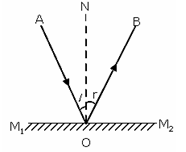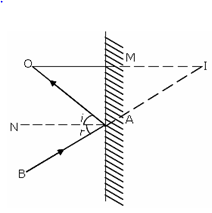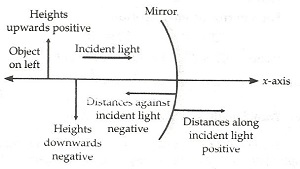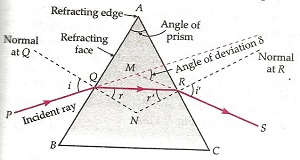CBSE Class 12 Physics
Revision Notes
Chapter-9
Ray Optics and Optical Instruments
- Reflection: When light is incident on a surface, it is sent back by the surface in the same medium through which it had come. This phenomenon is called 'reflection of light' by the surface.
- Laws of Reflection: The reflection at a plane surface always takes place in accordance with the following two laws:
(i) The incident ray, the reflected ray and normal to surface at the point of incidence all lie in the same plane.
(ii) The angle of incidence i is equal to the angle of reflection r, i. e., ∠i=∠r

- Formation of Image by the Plane Mirror: The formation of image of a point object O by a plane mirror is represented in figure.

The image formed has the following characteristics:-
(i) The size of image is equal to the size of object.
(ii) The object distance = Image distance i.e., OM = MI.
(iii) The image is virtual and erect.
(iv) When a mirror is rotated through a certain angle, the reflected ray is rotated through twice this angle. - Reflection of Light from Spherical Mirror:
a) A spherical mirror is a part cut from a hollow sphere.
b) They are generally constructed from glass.
c) The reflection at spherical mirror also takes place in accordance with the laws of reflection. - Sign Convention: Following sign conventions are the new cartesian sign convention:-
(i) All distances are measured from the pole of the mirror & the distances measured in the direction of the incident light is taken as positive. In other words, the distances measured toward the right of the origin are positive.
(ii) The distance measured against the direction of the incident light are taken as negative. In other words, the distances measured towards the left of origin are taken as negative.
(iii) The distance measured in the upward direction, perpendicular to the principal axis of the mirror, are taken as positive & the distances measured in the downward direction are taken as negative.

- Focal Length of a Spherical Mirror:
a) The distance between the focus and the pole of the mirror is called focal length of the mirror and is represented by f.
b) The focal length of a concave mirror is negative and that of a convex mirror is positive.
c) The focal length of a mirror (concave or convex) is equal to half of the radius of curvature of the mirror, i.e.,
f = R2 where R is the radius of curvature of the mirror. - Principal Axis of the Mirror: The straight line joining the pole and the centre of curvature of spherical mirror extended on both sides is called principal axis of the mirror.
- Mirror Formula:
1f=1u+1v
Where u = distance of the object from the pole of mirror
v = distance of the image from the pole of mirror
f = focal length of the mirror - Magnification: It is defined as the ratio of the size of the image to that of the object.
Linear magnification, m=IO=−vu
Where I = size of image and O = size of object.
Magnification, m is negative, implies that the image is real and inverted.
Magnification, m is positive, implies that the image is virtual and erect. - Image formation by a concave mirror:-
| S.No. | Position of object | Position of image | Nature of image | Size of image |
| 1 | Infinity | At F | Real and inverted | Highly diminished |
| 2 | Beyond C | Between F & C | Real and inverted | Diminished |
| 3 | At C | At C | Real and inverted | Same size as object |
| 4 | Between C & F | Beyond C | Real and inverted | Magnified |
| 5 | At F | At infinity | Virtual and upright | Highly magnified |
| 6 | Between F & P | Behind the mirror | Virtual & upright | Magnified |
- Image formation by a convex mirror:-
| S.No. | Position of object | Position of image | Nature of image | Size of image |
| 1 | Infinity | At F | Virtual & erect | Highly diminished |
| 2 | Between ∞ and P | Between P and F | Virtual & erect | Diminished |
- Refraction: The phenomenon of the change in the path of light as it passes obliquely from one transparent medium to another is called refraction of light.
- Laws of Refraction:
(i) The incident ray, normal at the point of incidence and refracted ray all lies in the same plane.
(ii) For the same pair of media and the same colour of light, the ratio of the sine of the angle of incidence to the sine of the angle of refraction is constant i.e.,
sinisinr=aμb
Where aμb is a constant known as Refractive Index of the medium b with respect to the medium a, i is the angle of incidence in medium a and r is the angle of refraction in medium b. - Methods to Determine Refractive Index of a Medium: Refractive index of a medium can also be determined from the following:
(i) μ=Velocity of light in airVelocity of light in the medium
(ii) μ=1sin c
Where c is the critical angle. - Critical Angle: The Critical angle is the angle of incidence in a denser medium corresponding to which the refracted ray just grazes the surface of separation.
- Total internal reflection: The phenomenon in which a ray of light travelling at an angle of incidence greater than the critical angle from denser to a rarer medium is totally reflected back into the denser medium is called total internal reflection.

- Apparent Depth of a Liquid: If the object is placed at the bottom of a transparent medium, say water, and viewed from above, it will appear higher than it actually is.
The refractive index μ in this case is:
Refractive index of the medium,
μ = Real DepthApparent Depth - Normal shift: The height through which an object appears to be raised in a denser medium is called normal shift.
d=t(1−1μ) - Refraction through a Single Surface: If μ1,μ2 are refractive indices of rare and denser media respectively, R is the radius of curvature of spherical surface.
When object is in rarer medium: μ2v−μ1u=(μ2−μ1)R
When object is in denser medium: μ1v−μ2u=μ1−μ2R
where u and v are the distances of the object and the image from the centre of the refracting surface of radius of curvature R respectively. - Refraction through a Thin Lens (Lens maker's formula): If R1 and R2 are radii of curvature of first and second refracting surfaces of a thin lens of focal length f, then lens-makers formula is 1f=(μ2−μ1μ1)(1R1−1R2)
If the lens is surrounded by air, μ1=1 and μ2=μ , then 1f=(μ−1)(1R1−1R2) - Image formation by a convex lens:-
| S.No. | Position of object | Position of image | Nature of image | Size of image |
| 1 | Infinity | At F | Real and inverted | Highly diminished |
| 2 | Beyond 2F | Between F & 2F | Real and inverted | Diminished |
| 3 | At 2F | At 2F | Real and inverted | Same size |
| 4 | Between 2F & F | Beyond 2F | Real and inverted | Magnified |
| 5 | At F | At infinity | Real and inverted | Highly magnified |
| 6 | Between F & O | Same side | Virtual & erect | Magnified |
- Image formation by a concave lens:-
| S.No. | Position of object | Position of image | Nature of image | Size of image |
| 1 | Infinity | At F | Virtual & erect | Highly diminished |
| 2 | Between ∞ and O | Same side | Virtual & erect | Diminished |
- Thin lens formula:
1f=1v−1u - Magnification Produced by a Lens:
m=IO=vu
Where I is the size of image and O is the size of object. - Power of a Lens: The power of a lens P is its ability to deviate the ray towards axis.
- Focal Length of Thin Lenses: The focal length (f) of thin lenses of focal lengths f1,f2,f3,...........placed in contact of each other is
- 1f=1f1+1f2+1f3+.......
- Refraction Through Prism: When a ray of monochromatic light is refracted by a prism, the deviation δ produced by the prism is δ=i+e−A
Where i = angle of incidence, e = angle of emergence, A = angle of the prism

- Angle of Deviation: The minimum value of the angle of deviation suffered by a ray on passing through a prism is called the angle of minimum deviation and is denoted by δm.
μ=sin(A+δm2)sinA2 - Dispersion: The splitting of white light into constituent colours is called the dispersion of light. A prism causes deviation as well as dispersion.
- The pattern of the coloured bands obtained on the screen is called spectrum.

- Angular dispersion: The angular separation between the two extreme colours (violet and red) in the spectrum is called the angular dispersion.
Angular dispersion=δV−δR=(μV−μR)A - Dispersive Power: It is defined as the ratio of the angular dispersion to the mean deviation.
ω=μV−μRμ−1 - Optical Instruments: Optical instruments are the devices which help human eye in observing highly magnified images of tiny objects, for detailed examination and in observing very far objects whether terrestrial or astronomical.
- Human Eye:
a) It is the most familiar and complicated optical instrument provided by nature to living beings. In this device, light enters through a curved front surface, called cornea, passes through the pupil – central hole in the iris.
b) The light is focused by the eye lens on the retina.
c) The retina senses light intensity and colour and transmits the electrical signals via optical nerves to the brain.
d) Brain finally processes the information. - Accommodation of the human eye: It is the ability of the eye lens due to which it can change its focal length so that images of objects at various distances can be formed on the same retina.
- Microscope:
a) A simple microscope is a short focal length convex lens.
b) The magnifying power of a simple microscope is M=1+Df
c) The magnifying power, M of a compound microscope when final image is formed at least distance of distinct vision-
M=Mo×Me=vouo(1+Dfe)
& when image is formed at infinity-
M=Mo×Me=Lfo×Dfe
where Mo and Me denotes the linear magnification of the objective and eye lens. - Telescope: It is an optical device which enables us to see distant objects clearly.
a) The magnifying power, M of refracting telescope is M=−f0fe, and L=(f0+fe) where L is the length of the telescope.
b) For the final image is formed at the least distance of distant vision, the magnifying power is M=−f0fe(1+feD)
c) The resolving power of a telescope = 1△θ=D1.22λ
Where, λ = wavelength of light, θ = angle subtended by then point object at the objective and D = diameter of the objective of the telescope.





